by Dave Arnold
Czimer’s Meats, outside of Chicago, specializes in hard to find meats. We ordered up some beaver, yak, a whole raccoon, some bear, and a lion steak. Lion?

It is illegal in the US to sell wild hunted game, so how does Czimer’s get these meats? Some of Czimer’s meats, like Yak, are farmed. In other cases the meat is a by-product that would be thrown away if not eaten. Czimer’s raccoons and beavers are wild animals that are trapped for fur. Perversely, although commercial hunting is illegal, selling meat from trapped animals is not –provided they are slaughtered in a USDA approved facility. Bears and lions are raised by big game dealers for circuses, exotic pet enthusiasts and zoos. When those animals get too old to breed or their owners discard them they are slaughtered for their fur and the meat goes to Czimer’s. Sad but true. If the animals are being slaughtered, it is a sin not to eat them.
Why cook these animals?
America used to be the place to eat strange animals. We were world renowned for the quantity, quality, and variety of our game. We ate wild animals, farmed animals, young animals, old animals. For an eye-opening reference, see Thomas DeVoe’s 1867 book The Market Assistant(free on Google books), which describes all the foods available in 19th century American markets. Now we eat a fairly small number of animals, almost all of them young. Hunters are the only people here who eat a wider variety of meat from animals of different ages. Because older animals are tougher, and wild game often lacks extensive marbling, hunters often have problems making meat as delicious as it could be. They frequently relegate game meat to highly sauced preparations or stews, or serve tiny chunks of meat fried in a heavy batter. I have had alligator seven times and I still don’t know what it tastes like; it’s always served as generic fried stuff with a gloppy sauce. Every hunter should adopt low temperature cooking to get the most out of their meat, which is what we did with our Czimer’s shipment – you get delicious and tender meat without overcooking and without masking natural flavor.Â
The meat we got from Czimer’s came frozen. We thawed it, then seared, then bagged with salt and butter, cooked low temperature, and finished in a raging deep fryer.
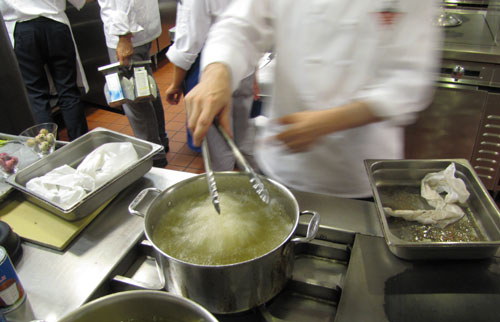
Most of the meat we ordered was in steak form. Unfortunately, these steaks were cut very thin. Czimer’s explained that most cooks grill these meats, and if they were cut thick they would be preposterously tough. They agreed to cut thicker for me next time. Here’s a rundown of the meats:
Yak:

Yak is delicious. Our piece arrived hard and tough, so I knew we’d have to cook it a while. I wanted it fairly rare, so I cooked it at 56 degrees C for 24 hours. It was great –tender and juicy. Strangely, it tasted a bit like duck breast — it had a bit of a livery taste that certain cuts of meat take on when you cook them a long time –duck, eye of round, etc. Usually, this liver flavor is a negative attribute. On yak it worked nicely. A definite do-again.
African Lion:

Lion tastes like pork with a special savory twang. The guy at Czimer’s told me lion tastes different because lions eat meat exclusively. The meat itself was very pale and soft when raw, so I figured I wouldn’t have to cook it a long time. It had very little intramuscular fat, so I thought the greatest challenge would be not drying the meat out. We cooked it at 60 C for 2 hours; it was good but still tough. Next time I would cook a little lower – maybe 58 C, and for a lot longer time –like 24 hours. It turns out that older meat can be tough even if it feels soft raw. Czimer’s explained that lion meat is always soft, and you can’t use the way it feels raw to judge how tender it will be after cooking. I liked lion, but don’t know that I would cook it all the time –I’ll stick with pork. It probably isn’t healthy to eat a lot of carnivore meat anyway (concentration of toxins, prion nonsense, etc).
Black Bear:
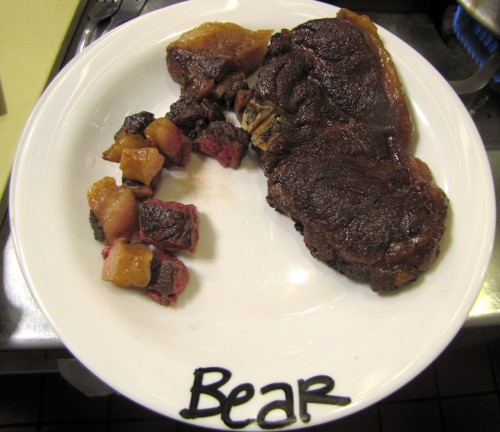
The bear meat was dark –almost black. Like the lion, it felt soft. Bear meat has to be cooked thoroughly to kill possible trichinosis parasites; I cooked it at 57 degrees C for 2 hours, which is sufficient for safety. Like the lion, it was still a bit tough. The bear meat started out slightly sweet, but I found it had an off-putting  metallic, bloody aftertaste. Nils didn’t mind it. I wouldn’t cook an old black bear again.
Racoon:
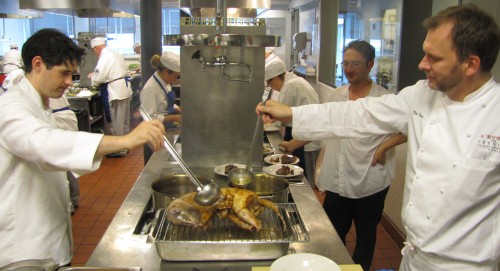
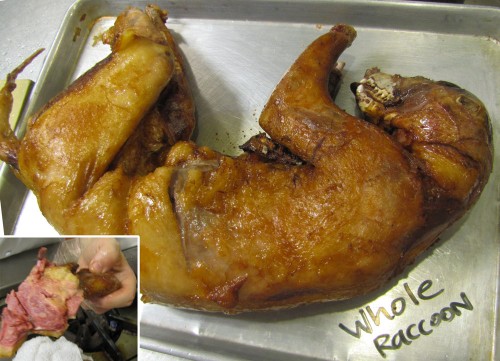
Racoon was a big disappointment. The one we had was whole. We cooked it at 60 for 5 hours. The meat was tough, and there wasn’t much of it. The fat wasn’t great either. If I were to cook raccoon again, I’d cook it a lot, lot longer –like 48 hours, shred the meat, and serve it pulled like pork.
Beaver:
When I called Czimer’s and asked for beaver tail, the guy asked whether I wanted the tail or the flapper. The tail, he explained, is a nice fatty chunk of meat from the posterior of the animal. The flapper is the tennis-racket looking appendage that, along with buck teeth, are the signature characteristics of the beaver. He said that a lot of people call and ask for the flapper, but they are always disappointed, because there isn’t any meat on it. “It’s pretty useless,†he said. I took that as a challenge. “I’ll take two flappers and a tail,†I replied.
In medieval times, good Christians were forbidden from eating meat on many days of the year. Fridays, Wednesdays, Lent, and other Saint’s days were fast days. Meat, dairy and eggs were not allowed, but fish was. The human mind being strange, and the scientific classifications of Linnaeus being far in the future, the medieval cook got around these rules by classifying mammals like whales as “fish.” Even stranger, while the body of the beaver was considered an animal (verboten on fast days), the tail was considered fish and could be consumed whenever. God knows what they would have done with the platypus. I suspect that it is the medieval food recreactionists who have been calling Czimer’s looking for the beaver tail, only to be disappointed by the paucity of culinary possibilities for the flapper.
Here is what I did:
The Tail:

Beaver tail is straight up fantastic. It has a woody-musky aroma and flavor that is unique among all meats I have tried. Nils went bonkers for it as well. Every recipe for beaver I could find advised soaking the meat in vinegar, so I brined the tail in a mild salt and vinegar solution before searing it and bagging it with butter. I cooked it at 60 degrees C for 48 hours. Man, was it good.
The Flapper:
Beaver flapper is basically skin, fat and cartilage with a bone running up the middle. We figured if it was going to be good at all we’d have to treat it like a pigs ear -cook it at high temperature to gelatinize the connective tissue, then crisp it up in the fryer. Since we had two, I cooked one whole and the other we blanched and skinned.

The blanched and skinned one was a gloppy fatty mess. Maybe it would have been good for something, but we were tasting it after we had tasted all the other meats and we weren’t in the mood. The whole flapper puffed up nicely in the fryer but we deemed it too fatty and weird for general enjoyment.
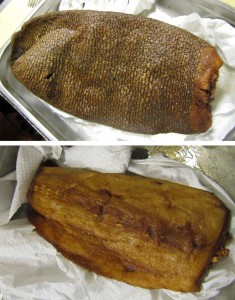
Watching it puff up gave me an idea –beaver flapper chicharron. I took the skin from the second flapper, cooked it in boiling salted water, then cooled it, scrapped off the excess fat, and dehydrated till it felt plastic-y (see our post on puffed snacks). When I fried the pieces, they puffed up beautifully and still had that woodsy beaver flavor that we all loved. I fed it to an amphitheater full of students at a demo Nils and I did a few weeks back; they seemed to like it too. Call up Czimer’s and get your flapper while they last.
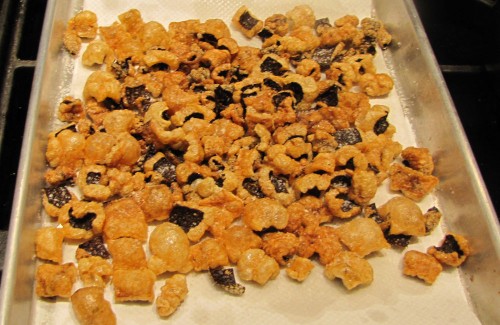

Each time you guys post, I want to declare it’s the best post EVER. This is no different. My favorite quote from the article: “I wouldn’t cook an old black bear again.”
Thank you Sygyzy.
Now, I’m dying to taste the Beaver Tail!
Can you give us the ratios for your beaver tail brine?
I wish we had written it down. We just did it to taste.
great post, it’s interesting how these meats have been forgotten especially seeings as really not that long ago (100 years) people in the “wild” west would of been downing racoon, beaver and bear no problems. But I guess even offal has the same problem now too.
side note, great to see some higher res photos
Heh. I had heard nothing but bad things about bear and raccoon – apparently bear fat rancidifies very quickly, but it sounds from your experience like the meat itself also is nothing to write home about. And, I don’t know, raccoon has that roadkill quality.
About the beaver, it’s interesting you should mention the whole medieval fasting days thing – I was just reading a book about medieval British cuisine and the classification of random water-dwelling animals as “fish” to circumvent the proscription against eating meat. They did mention beaver (as well as whale, not to mention swan and other watergoing birds). I had a hard time understanding why anyone would go to such lengths for whale, but now the effort to keep beaver on the daily menu makes a lot more sense.
Given the controversies over whale meat I’ve always been kindof curious about it. It sounds like some Norwegians and Icelanders are the only ones who think it tastes any good at all while the Japanese always have trouble consumer their whale catch, although whale meat consumption has negative cultural/historical associations there. A lot of the people writing about international whaling controversy take it on economic faith that because the market has no demand for whale meat it must taste terrible, but that isn’t necessarily the case.
Interesting,
The only whale recipe I have is in my old international buffet book. It calls for Norwegian whale. I’ve obviously never tried it.
If I recall correctly, there’s something in my old Larousse Gastronomique about duck being formerly classified as fish for fasting purposes. There’s also a story online at http://www.catholic.org/national/national_story.php?id=23328 about an area of Michigan where the residents have a special dispensation to eat muskrat during Lent.
Howdy John,
I hear muskrat tastes good.
Yep, muskrat was served at none other than Delmonico’s in NYC back in the day. They sold it as “marsh rabbit.”
Marsh rabbit is a much better sale on a menu than muskrat.
that photo of you guys basting the raccoon should be your Holiday Card this year!
My husband is always sending me your posts and I’m always impressed, but this may be my favorite so far.
My brother and I grew up with my mom’s tales of eating every part of bear, elk, deer, rabbit, pheasant, duck, quail, possum, etc. (her family ate whatever her dad could hunt). Her stories were generally of the “you should be glad I’m not feeding you X” variety.
Nowadays, while she pretty much eats just chicken & fish, my brother and I will pretty much try anything. You are so right about alligator – always barely indiscernible from popcorn shrimp
I’m sending her this post so she can see that her dislike of bear is shared even by accomplished chefs!
Thank you for the kind words.
This was an interesting post. You are certainly more adventuresome than I would be!
As for the product sourcing, unfortunately Czimer is not without a past and controversy:
http://money.cnn.com/2010/06/23/smallbusiness/world_cup_lion_burger/index.htm
Hello Sous Vidist:
I’m just finding this stuff out now.
I thought Czimer’s sounded familiar: Richard Czimer served 6 months in prison in 2003 for selling federally protected tiger and leopard meat as “lion meat.” Sounds like his sources are still somewhat shady: http://money.cnn.com/2010/06/23/smallbusiness/world_cup_lion_burger/index.htm
Did you get any info about that?
Meanwhile, it looks like Ken Albala’s bear roast came out well: http://kenalbala.blogspot.com/2008/11/bear-butt.html
Hey Paul A.
I did not know about the 2003 prison sentence. I did some research on the 2003 case. The goings on back then leave me a little uneasy. I’m still doing more research.
At Aronia de Takazawa in Tokyo they have served black bear prosciutto that they cure themselves. Could be something to look into.
I just placed an order for some camel meat (never got to try it visiting the mid. east) and threw in a couple of beaver tails.
I don’t have a low temp cooker, any advice?
Maybe I should have thought about that before ordering…. Naaah! this will be fun!
Post a comment with a picture of the meat. What do you think it cooks like? Is it more like beef (55-57 c) or more like pork (60 C). I would run a small test and cook some a long time, like 24 hours, to see if it goes liver-y
The camel was fantastic, I’m not sure how to post a pic here but I’ll put one up on the forum. It was surprisingly well marbled.
I don’t have access to a low temp cooker; it looked like beef so I decided to grill it. It came out really well. I seasoned simply with salt and pepper to try and get the most camel flavor I could. It tasted similar to beef but maybe a little sweeter. It also remained as tender as beef. For the price I’m not sure I would purchase again (pushing $18/lb + delivery) but was quite the experience.
The beaver was a different story. As I didn’t have access to low temp cooker I decided to smoke it like a brisket. I was surprised how strong the raw meat smelled. I brined in salt solution (about a 1/4 cup to a quart of water) to draw out blood. I smoked at 250-300 *f for about 3 hours after coating with mustard and dry rub. The flavor was quite nice (pretty much as described in the original post) but the texture was less than stellar (dry dry dry). It will be going into pulled beaver sandwiches for lunch this week. If I were to do it again I’d definitely do a wet heat like a braise or maybe even stew it.
Thanks for the info. Nastassia wanted to try the camel.
This is awesome. Thanks for sharing. I think I may look into this…
It is interesting how these meats have been forgotten especially seeings as really not that long ago (100 years) people in the “wild†west would of been downing racoon, beaver and bear no problems.
I read these blog posts earlier in the year. I thought you might be interested in some more historical perspective on bear meat:
http://www.fourpoundsflour.com/history-dish-mondays-roast-bear/
http://www.fourpoundsflour.com/videohistory-tastes-like-bear-meat/
-AJ
Sounds like her bear was better than mine. I bet that a lot depends on the age of the bear, what it was eating, etc. No one would have mistaken our bear meat for beef –ever.
Great Post. I never saw a piece of meat I didn’t like – I would make an exception in the case of the racoon. No such thing as strange meat – bring them on.
I wonder if you guys are going to eat people that die too? After all, what a waste of meat… They’re already dead… why now eat them? Eat your relatives, family… hell, why not cut a part of your own leg and give it a try?
I stumbled in your blog, started to like it until I saw this post. This is a disgusting post.
Sorry for you…
I’m sure in the most of extreme of circumstances. Many many people have (The crash in the Andes) for example, and still would eat Human flesh. Would you rather see your children starve to death or stay alive by consuming, what after all is just ‘Meat’. Does the Church not ‘symbolically’ feed it’s flock ‘The Body of Christ’?
I read a book about Lewis and Clark’s cross country journey called Undaunted Courage earlier this year and there are several diary entries from the trip relating how beaver tails (flappers) were some of their favorite protein on the trip, over deer and bear, etc. I think they just roasted them over an open fire…
I commend your enthusiasm for experimentation, but you seem so quick to judge.
The taste of bear really depends on what it’s been eating. Spring bear can be quite delicious (and frankly not all that different from beef).
Deep-frying a raccoon seems ill-advised, guaranteed to emphasize the fat rather than the meat, and pulled-pig a much better idea. I made goulash out of a raccoon for a dinner party, and everyone quite liked it. Since then, I’ve been using the stock I froze in risottos, soups, etc., to good effect; it adds a richness on par with, say, duck broth.
http://madisonforager.wordpress.com/2009/12/12/raccoon-report-on-the-edibility-of-one-procyon-lotor/
Howdy Kate,
I have heard that spring bear is good.
The deep frying doesn’t really add a lot of oil, its just the best way to crisp it up. I agree that the raccoon would probably be better in a stew kinda situation.
Raccoon needs the pulled pork treatment, and there are glands on the hind legs that, if not removed, put an off taste in the whole shebang.
Howdy Hank,
I don’t know if the processor removed the glands (I know I didn’t).
I agree that raccoon is nasty: meat is stringy and the taste is nothing to write home about (had it in a Brunswick Stew). Bear, however, is delicious in a stew or cooked like pot roast. For me the best game meat is big horn sheep – surprisingly un-lamb like.
Keep up the good work and help people own the carnivoreship
Thanks for helping spread the word about yak meat. Is the “bag” technique sous vide? Sorry, I am not a chef! We have focused on low heat and slow methods and have tried a primitive “sous vide at home” process but had difficulty with controlling the temp. Even though we ended up too hot, the meat still came out moist and tender, just well done. What cut did you use?
Thanks,
Howdy,
I don’t remember the cut. We did cook it sous vide (although a zip loc would have worked fine). As you know, temperature control is the most important thing for us. Can we buy direct from you?
Yes, you can buy direct from us. We aren’t a large operation so inventory can be limited but we would love for you to try our yak. Let us know what you would be interested in.
Thank you!
are you sure that is in fact a racoon and not a dog???
Pretty sure.
Look’s just like a giant version of Guinea Pig which I’ve eaten in Peru. All over the world people turn up their noses at certain types of food, in France (Snails and Frog Legs), certain countries still eat Whale meat, Spiders, Seal (not the singer!), Bush meat including Monkeys and Apes and in Scotland the Lesser Spotted Haggis!
I love the bit about the beaver tail, I work on a small island in Michigan’s Lake Huron, where the Fur Trade traffic was very very busy during the 18th/19th centuries, and as a living history costumed interpreter I tell our guests all the time about eating beaver tail! Though I’ve never actually tried it, now I have some modern cooks to reference. awesome! thanks.
Awesome Bri! Give us a holler after you try it.
Being Mexican that chicharron idea really piqued my interest. I’d ask my mom to make some, but she’d probably just look back at me in horror.
Do it. You won’t be sorry.
The raccoon looks like a fossilized infant from Pompeii
Wow.
Sick. Let’s kill even more! Maybe you should try what is the taste of a 2, 4, 15 and 55 year old human. Start with you parents first.
Sorry D, My parents are already older than your test numbers require.
I always enjoy insane rants –especially by people who don’t actually have enough guts to leave a real email response address.
Perhaps you have not considered that a pig’s life, or a cow’s life, or a chicken’s is worth as much as a beaver’s or a raccoon’s or a bear’s. The fact of the matter is that as a society, the majority of us eat meat –a practice which necessitates taking a life. If your problem is with all meat eating, I respectfully suggest that you take on groups of people who kill large numbers of animals on a daily basis –someone like Gwaltney. If your problem is specifically with the death of the animals in the post I’d have to say your feelings are illogical and unthinking (not to mention rude and insensitive –you don’t know anything about my life or my parents).
On a side note, as you equate these animals to people’s parents, what was it like being raised by raccoons in the woods?
Noticed you cooked the bear at 135 degrees F. Don’t you need to go to 137 – minimum- to kill trichinae parasites? I plan on sous viding a bear roast, too, but I was going to bring it up to 148-150 degrees…
Trichinae are killed at 135 (provided you cook long enough). I did a bunch of research on USDA (an sneaking a peak at Myhrvold/Young’s numbers). I don’t have the time-temp references in front of me however.
So maybe bring the temp down on the bear roast to, say 145 degrees and hold it for 2-3 hours? Would that work, safetywise?
Yeah, that should be safe. Even lower if you want. I’ll try to find the numbers
Iam a vegetarian and i obviously didnt like this! but especially the picture of the whole raccoon who was stripped of its fur before being cooked…its hard to look at a picture like that and not feel sad…:(
Hi Lorena,
I understand where you are coming from but I think it does us meat eaters good to occasionally see the whole animal we are eating. The way meat is pre-cut and pre-packed in this day and age allows us to ignore the fact that we are taking a life when we eat meat.
It might not be fashionalbe to invoke religion, but vegeterianism is un-christian. If it is meat, bring it on – God made all those animals to put at the service of mankind.
Another vegetarian over here. Honestly, I don’t find anything offensive about this post (though the lion did make me pause for a sec). You’re absolutely right. What makes a beaver any different than a cow if we’re talking ethics? You still have to come to terms with the fact that you must kill in order to eat meat. That’s the reality and people shouldn’t shy away from that. Nice and polite cuts of meat shelter us from the animal so let’s see a whole animal once in a while to remember. It really shouldn’t be gross or icky to see the above pictures if you eat meat (not even gross to me).
You’re also right about food choices in the marketplace. It’s not just meat. There are so many varieties of veggies that we can’t get at a market. Now we just have “tomatoes” or “carrots”. God forbid I find kohlrabi at a regular supermarket.
Thanks for the voice of reason Graciela!
Hi Dave,
You helped me out with some ham’s at christmas time… all worked out well!! This is a great post, anyway, I am living and working in Shanghai, and found some “Rice Birds” or Ma Qiao (i think). Anyway, tiny sparrow type birds that I deep fried whole, with great results (cannot wait to do a “Sunday Roast” finger food edition)!! But for now I want to treat them like “Potted Prawns”, I’m thinking about 64 degrees for an hour in a jar of duck fat! Any thoughts?? BTW, to the critics “D and Co”, have a read about endo and exo cannibalism! Also, Gay Bilson’s thoughts on blood sausage!!
Holy Crap!!!!!!!!!!!!!!!!!!!!!!!!!!!!!!!!!!!!!!!!!!!!!!!!!!!!!!!!!!!!!!!!!!!!!!!!!!!!!!!!!!!!!!!!!!!!!!!!!!!!
I’ve wanted to try those forever. I also want ortolan and bobolink (our rice bird). I don’t think you need to go that high on them but you should be able to use any ortolan recipe. Tell me how they are.
Having a go at Ducasse’s “Ortolan Confit”, 240c for 6 min in duck fat, great result, but I am really keen on trying to “pot” the birds…how low do you think I can go with them? If you ever get to Shanghai, there is some definitely some good eating (my kitchen boys have taken me out for bear and camel hump hotpot, obviously snake as well as bulls dick, sheep balls and scorpions)!. BTW I think I shall splash the Ortolan with armagnac in the bag to give the scent of how they usually “process” them! Shall send some pics if all works well!
I wouldn’t go below 55 –like for squab. Please tell me what hapens.
For the love of the lord, Why would you cook and eat lion?
For the love of the Lord, why would you throw away meat from an animal that was being killed for an alternative purpose?